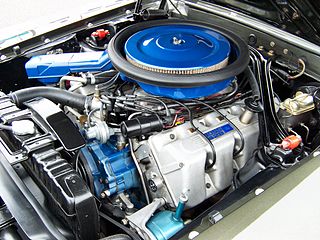
The Ford 385 engine family is a series of big-block V8 engines designed and manufactured by Ford Motor Company. The family derives its 385 name from the 3.85-inch (98 mm) crankshaft stroke of the 460 cubic-inch V8 introduced in 1968. A 429 cu in (7.0 L) version was also introduced the same year, with a 370 cu in (6.1 L) variant appearing in 1977.

The Ford 335 engine family was a group of engines built by the Ford Motor Company between 1969 and 1982. The "335" designation reflected Ford management's decision to produce an engine of that size with room for expansion during its development. This engine family began production in late 1969 with a 351 cu in (5.8 L) engine, commonly called the 351C. It later expanded to include a 400 cu in (6.6 L) engine which used a taller version of the engine block, commonly referred to as a tall deck engine block, a 351 cu in (5.8 L) tall deck variant, called the 351M, and a 302 cu in (4.9 L) engine which was exclusive to Australia.
The Y-block engine is a family of overhead valve V8 automobile engines produced by Ford Motor Company. The engine is well known and named for its deep skirting, which causes the engine block to resemble a Y. It was introduced in 1954 as a more modern replacement for the outdated side-valved Ford Flathead V8 and was used in a variety of Ford vehicles through 1964.

The Ford Modular engine is Ford Motor Company's overhead camshaft (OHC) V8 and V10 gasoline-powered small block engine family. Introduced in 1990, the engine family received its “modular” designation by Ford for its new approach to the setup of tooling and casting stations in the Windsor and Romeo engine manufacturing plants.

The Chrysler Hemi-6 engine is a family of inline six-cylinder petrol engines produced by Chrysler Australia in three piston displacements and multiple configurations. Hemi-6 engines were installed in Australian-market Chrysler Valiants from 1970 through 1981. It was also installed in the Valiants closely related variants, the Chrysler VIP, the Chrysler by Chrysler & the Valiant Charger.

The General Motors LS-based small-block engines are a family of V8 and offshoot V6 engines designed and manufactured by American automotive company General Motors. First introduced in 1997, the family is a continuation of the earlier first- and second-generation Chevrolet small-block engine, of which over 100 million have been produced altogether, and is also considered to be one of the most popular V8 engines ever. Spanning three generations, a new, sixth generation is expected to enter production soon. Various small-block V8s were and still are available as crate engines.
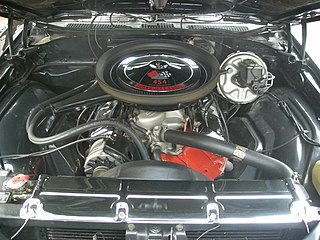
The Chevrolet "big-block" engine is a term for a series of large-displacement, naturally-aspirated, 90°, overhead valve, gasoline-powered, V8 engines; that were developed and produced by the Chevrolet Division of General Motors, from the 1950s until present.

The Chevrolet small-block engine is a series of gasoline-powered V8 automobile engines, produced by the Chevrolet division of General Motors between 1954 and 2003, using the same basic engine block. Referred to as a "small-block" for its size relative to the physically much larger Chevrolet big-block engines, the small-block family spanned from 262 cu in (4.3 L) to 400 cu in (6.6 L) in displacement. Engineer Ed Cole is credited with leading the design for this engine. The engine block and cylinder heads were cast at Saginaw Metal Casting Operations in Saginaw, Michigan.

Power Stroke, also known as Powerstroke or PowerStroke, is the name used by a family of diesel engines for trucks produced by Ford Motor Company and Navistar International for Ford products since 1994. Along with its use in the Ford F-Series, applications include the Ford E-Series, Ford Excursion, and Ford LCF commercial truck. The name was also used for a diesel engine used in South American production of the Ford Ranger.
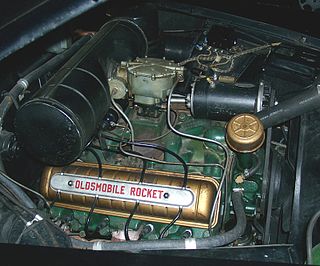
The Oldsmobile V8, also referred to as the Rocket, is a series of engines that was produced by Oldsmobile from 1949 until 1990. The Rocket, along with the 1949 Cadillac V8, were the first post-war OHV crossflow cylinder head V8 engines produced by General Motors. Like all other GM divisions, Olds continued building its own V8 engine family for decades, adopting the corporate Chevrolet 350 small-block and Cadillac Northstar engine only in the 1990s. All Oldsmobile V8s were assembled at plants in Lansing, Michigan while the engine block and cylinder heads were cast at Saginaw Metal Casting Operations.

The Buick V8 is a family of V8 engines produced by the Buick division of General Motors (GM) between 1953 and 1981. All were 90° water-cooled V8 OHV pushrod engines, and all were naturally aspirated except one turbocharged version of the 215.
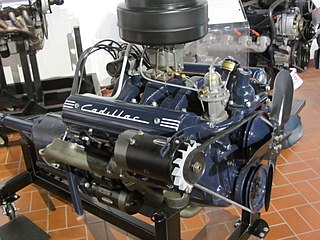
The term Cadillac V8 may refer to any of a number of V8 engines produced by the Cadillac division of General Motors since it pioneered the first such mass-produced engine in 1914.

The Ford flathead V8 is a V8 engine with a flat cylinder head introduced by the Ford Motor Company in 1932 and built by Ford through 1953. During the engine's first decade of production, when overhead-valve engines were used by only a small minority of makes, it was usually known simply as the Ford V‑8, and the first car model in which it was installed, the Model 18, was often called simply the "Ford V-8" after its new engine. An automotive milestone as the first affordable V8, it ranks as one of the company's most important developments. The engine was intended to be used for big passenger cars and trucks; it was installed in such until 1953, making the engine's 21-year production run for the U.S. consumer market longer than the 19-year run of the Ford Model T engine. It was also built independently by Ford licensees.. The engine was named on Ward's list of the 10 best engines of the 20th century. It was a staple of hot rodders in the 1950s, and it remains famous in the classic car hobbies even today, despite the huge variety of other popular V8s that followed.
The Ford Motor Company produced straight-six engines from 1906 until 1908 and from 1941 until 2016. In 1906, the first Ford straight-six was introduced in the Model K. The next was introduced in the 1941 Ford. Ford continued producing straight-six engines for use in its North American vehicles until 1996, when they were discontinued in favor of more compact V6 designs.
The Ford MEL is a big-block 90° V8 engine family produced in various configurations by the Ford Motor Company between 1958 and 1967 in displacements from 383–462 cubic inches (6.3–7.6 L), and used in Ford, Edsel, Mercury, and Lincoln vehicles.
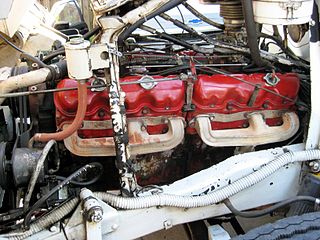
The GMC V6 is a family of 60-degree V6 engines produced by the GMC division of General Motors from 1959 through 1974. It was developed into both gasoline and diesel versions, and produced in V8 and V12 derivatives. Examples of this engine family were found in pickup trucks, Suburbans, heavier trucks, and motor coaches.

The AMC V8 may refer to either of two distinct OHV V8 engine designs that were developed and manufactured by American Motors Corporation (AMC). The engines were used in cars and trucks by AMC, Kaiser, and International Harvester as well as in marine and stationary applications.

The Lincoln Y-block V8 engine was Ford's earliest OHV V8 engine, introduced by Lincoln in the 1952 model year. Like the later and better-known but even more short-lived Ford Y-block engine, its block's deep skirts gave the block the appearance of the letter Y from the front.

The Chrysler Hemi engine, known by the trademark Hemi or HEMI, refers to a series of high-performance American overhead valve V8 engines built by Chrysler with hemispherical combustion chambers. Three generations have been produced: the FirePower series from 1951 to 1958; a famed 426 cu in (7.0 L) race and street engine from 1964-1971; and family of advanced Hemis (displacing between 5.7 L 6.4 L from 2003 to 2024.

Boss is the internal name for a family of large-displacement V8 engines from Ford Motor Company intended to compete with Chrysler's Hemi and General Motors' 6.0 L Vortec engines. Originally, Ford developed the engine architecture under the name Hurricane; however, development of the engine was delayed because of its temporary cancellation in 2005. It was revived in early 2006 by Mark Fields and was given the new name of Boss in light of the devastation caused by Hurricane Katrina in 2005. In spite of this change, Ford did not officially market the engines with the Boss name in any production vehicle where they were used, instead referring to the engines by their displacement.
















